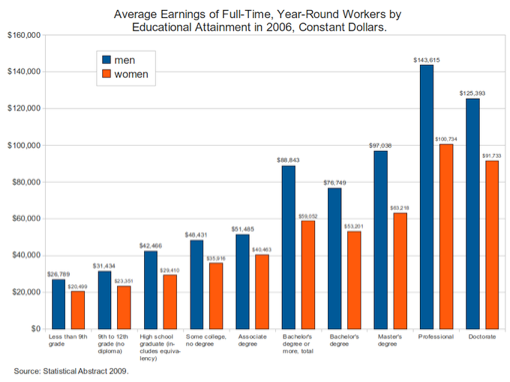Lesson 3: Gender Diversity
Attention

Learning Outcomes
Upon completion of this lesson's material, students will be able to:
- Recognize, describe, and explain social institutions, structures, and their relationship to individual perceptions of gender.
Teaching
In the second half of the 20th century (1950+), rapidly changing roles of North American and European women were resisted by many men because it inevitably resulted in changes in their roles as well. Male and female roles do not exist independent of each other. Cultural institutions [Sociologically speaking- this includes; family, education, religion, and economic and political institutions] are integrated and often interdependent- which, can be, a major source of resistance to change. Needless to say, it is a source of frustration for both those who want to change and those who do not. What might this mean in the context of gender equality?
Gender diversity means the proportion of males to females in the workplace. Is it a more even distribution or is the employee pool composed of mostly males or mostly females? Is that an easy question? This can have an effect on how people interact and behave with one another in the workplace and would impact culture and social environment. Can you think of examples??
Types of Gender Discrimination
Sex discrimination, or gender inequality, is unequal treatment based solely on gender. Treatment must be unequal, not simply different. Providing separate restroom facilities is not discrimination, but using separate criteria for promotions is discriminatory. Failure to provide equal pay for equal work is discrimination, as are criteria for bonuses based on gender. Discrimination against women because of pregnancy is not legal; pregnancy and giving birth must be treated the same way as any temporary condition. Job offers and hiring based on gender -- or stereotypes or assumptions about gender (cultural gender roles) --are discriminatory, for example, in professions such as nursing that are traditionally associated with one gender. [Visualize the following professions: Nurse, Teacher, Lawyer, Doctor, Police, Fire fighter, Soldier, Writer, etc.] What gender(s) were the individual(s) you visualized? Why? What influenced these 'beliefs.'
Harassment
Harassment in the workplace is a form of gender discrimination and takes many forms, including bullying and sexual harassment. The latter includes off-color jokes, suggestive photos, inappropriate physical contact and unwanted sexual overtures. Promises of promotion or other benefits made to an employee by an upper-level employer or manager in return for sexual favors is sexual harassment, as are threats of job loss if the favors are not granted. These interactions can be overt or covert, direct or indirect.
Remember, the "place" for women and men in society's cultural expectations may vary based on race, religion, ethnicity, age and/or the socio-political ideologies of a given time period. Social Guidance videos were presented and prepared in the 1940s-1960s in an effort, in part, to reinforce cultural expectations. Cultural controls through implied messages have run rampant in American culture presented on television and in marketing and media through the ages. The influx of immigration and changes brought by various socio-political movements can influence expectations, at any given time. How do socio-political expectations influence different systems of community, including family & education?
Attitudes Toward Working Women in the 1950s
Click HERE to view this directly on YouTube
Women in the Workplace: A Struggle for Equality
Click HERE to view this directly on YouTube
Definitions from Gender Diversity.org
Biological Sex: Sex refers to our biological and physical anatomy. Biological sex is used to assign gender at birth. For most people, biological sex and gender are aligned. However, many variables can factor into one's biological sex; for example, a person's chromosomal or anatomical configurations. These and other factors can combine in such a way as to make biological sex much more complex than two distinct categories.
Gender Identity: Unlike biological sex—which is assigned at birth and based on physical characteristics—gender identity refers to a person's innate, deeply felt sense of being male or female (sometimes even both or neither). While it is most common for a person's gender identity to align with their biological sex, this is not always the case. A person's gender identity can be different from their biological sex.
Increased societal understanding and scientific research exploring the origins of gender are serving to expand formerly simplistic societal notions of limited gender categorization. Gender identity and other recently defined terms are ones that are more inclusive of these normal variations of gender. Because gender identity is internal and not always visible to others, it is something determined by the individual alone.
Gender Expression: In contrast to gender identity, gender expression is external and is based on individual and societal conceptions and expectations. It encompasses everything that communicates our gender to others: clothing, hairstyles, body language, mannerisms, how we speak, how we play, and our social interactions and roles. Most people have some blend of masculine and feminine (societally defined) qualities that comprise their gender expression, and this expression can also vary depending on the social context i.e.; attire worn at work rather than play, hobbies or interests, etc.
Gender Variance/Gender Non-Conformity: Gender variance refers to behaviors and interests that fit outside of what we consider 'normal' for a child or adult's assigned biological sex. We think of these people as having interests that are more typical of the "opposite" sex; in children, for example, a girl who insists on having short hair and prefers to play football with the boys, or a boy who wears dresses and wishes to be a princess. These are considered gender-variant or gender non-conforming behaviors and interests. It should be noted that gender nonconformity is a term not typically applied to children who have only a brief, passing curiosity in trying out these behaviors or interests.
Gender Fluidity: Gender fluidity conveys a wider, more flexible range of gender expression, with interests and behaviors that may even change from day to day. Gender fluid people do not feel confined by restrictive boundaries of stereotypical expectations of women and men. For some people, gender fluidity extends beyond behavior and interests, and actually serves to specifically define their gender identity. In other words, a person may feel they are more female on some days and more male on others, or possibly feel that neither term describes them accurately. Their identity is seen as being gender fluid.
For additional terms to understand please click HERE or listen to this PODCAST
Gender Discrepancies in the Workplace
Though it is illegal for employers to use certain discriminatory practices when hiring employees. While these laws protect individuals from discrimination, differences do still exist on the job. Differences occur in the salaries men and women earn as well as the distribution of the sexes among occupations. An employer cannot discriminate against a woman based on her gender, but statistics show that discrepancies continue.
Wage Differences
According to the U.S. Census Bureau, the median income for women in 2009 for full-time employment was $36,278 while men during the same period earned a median annual salary of $47,127. Median weekly earnings for women in 2010, according to the U.S. Bureau of Labor Statistics, were $669 and $824 for men, which is nearly a 20% gap in wages. The gap is larger between professional men and women, with women earning a median weekly salary of $923 to the men's median weekly salary of $1,256 in 2010, according to the U.S. Bureau of Labor Statistics.
Gender Gap is an app designed to raise public awareness of the differneces in pay between the sexes in the US.
By contrast, I have included the video below from Prager University that provides a different explaination for the perception of gender related pay differences.
Click HERE to view this directly on YouTube |
Advancement Opportunities
Advancement opportunities are available for both genders, but women often have to work longer in a lower level position before advancing. According to Women's Media, the National Center for Education Statistics reports women work three years longer as a teacher before advancing to a principal position than men.
Related Reading: Implications of Gender Bias in the Workplace
Occupational Distribution
Gender differences exist in the types of jobs men and women choose. According to the U.S. Bureau of Labor Statistics, men dominate blue-collar jobs while women dominate clerical and service positions. The U.S. Bureau of Labor Statistics reports the differences in the occupational distribution among men and women is the result of voluntary choice or personal preference. The U.S. Bureau of Labor Statistics information illustrates that in 2001, 31 percent of men or women would have to change occupations for gender equality across all occupations. Could factors, other than preference, play a role? How? Why or Why not?
Exclusion
Exclusion is a barrier some women face while on the job, according to Gender Awareness Workshop facilitator Barbara Annis. The exclusion occurs for women on the golf course, at sporting events and get-togethers among men after traditional business meetings. Women experience exclusion from these activities, which many view as a disadvantage on the job. Women list additional obstacles on the job such as testing, tokenism and being dismissed or interrupted during meetings. http://smallbusiness.chron.com/gender-differences-workplace-statistics-13294.html

Missrepresentation
Written and directed by Jennifer Siebel Newsom, Missrepresentation calls out mainstream media for its limited and often degrading portrayals of girls and women. The documentary intertwines interviews with teenage girls with ones featuring famed women such as Condoleezza Rice, Nancy Pelosi, Lisa Ling, Rachel Maddow and Gloria Steinem. The interviews are bolstered by compelling statistics such as this one: 53 percent of 13-year-old girls are unhappy with their bodies, but that number increases to 78 percent by age 17.
TED Talks: Why we have too few women leaders.
It's not a Glass Ceiling, it is a Stickly Floor
Assessment

Lesson 3 Assignment
For this assignment you are going to write a paper.
Reflect on the relationship between the concepts presented in this lesson and your own perceptions of the gender and inequality.
Submit an essay to the assignment dropbox. Your paper should include
- Title page
- introductory paragraph
- three elaborated paragraphs of your reflections. Be sure to use the terms described in this lesson.
- Describe the resources used to inform your ideas. (Please read here that you are expected to use OUTSIDE resources - legitimate websites, newspaper articles, research articles, etc. to support your ideas.)
- Conclude with a summarizing paragraph that reviews your thoughts and their applications in the field of mental health.
- Include a reference page with APA formatted citations.
Lesson 3 Discussion
Discuss the different perceptions presented by the app "Gender Gap" and the information in the Prager U video. Discuss why it is important to have multiple viewpoints on this issue.

